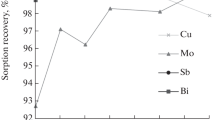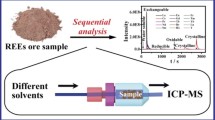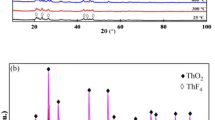Abstract
The efficiency of using rare earth metals largely depends on their impurity composition, which affects the structure and properties of materials. Before the analytical control of materials based on rare earth elements (REEs) and the starting materials for their production, the task is to determine both macrocomponents with high accuracy and impurities with high sensitivity, correctness, and precision. To determine the impurities in REE-based materials in the range from 10–5 to 5.0 wt %, a complex of methods of atomic emission and mass spectral analysis is frequently used. However, the analysis of REE-based materials, even using these modern highly sensitive methods, is a difficult task due to spectral and matrix interferences. Therefore, different separation/preconcentration procedures are needed to determine both rare earth and non-rare-earth impurities. This article reviews publications of preconcentration methods for spectral and mass spectral methods of analysis of materials based on REEs and some other analytical methods. It is shown that the most common approaches are liquid extraction and chromatography. Sorption, cloud-point extraction, and precipitation are also used. There is no universal approach. Each method discussed in this article has its advantages and limitations. The analytical completion of the method confirms the effectiveness of the selected separation/preconcentration method in each specific case.
Similar content being viewed by others
REFERENCES
Li, D., Li, Y., Pan, D., Zhang, Z., and Choi, C.J., Prospect and status of iron-based rare-earth-free permanent magnetic materials, J. Magn. Magn. Mater., 2019, vol. 4691, pp. 535–544.
Baranovskaya, V.B., Karpov, Yu.A., Petrova, K.V., and Korotkova, N.A., Actual trends in the application of rare-earth metals and their compounds in the production of magnetic and luminescent materials: A review, Russ. J. Non-Ferrous Met., 2021, vol. 62, no. 1, pp. 10–31.
Ritter, S.K., A whole new world for rare earths. How the technologically important metals rose from obscurity to ubiquity, Chem. Eng. News, 2017, vol. 95, no. 34, pp. 30–34.
Petrova, K.V., Baranovskaya, V.B., and Korotkova, N.A., Direct inductively coupled plasma optical emission spectrometry for analysis of waste samarium–cobalt magnets, Arabian J. Chem., 2022, vol. 15, no. 1, p. 103501.
Korotkova, N.A., Petrova, K.V., and Baranovskaya, V.B., Analysis of cerium oxide by mass-spectral and atomic-emission methods with inductively-coupled plasma, J. Anal. Chem., 2021, vol. 76, no. 12, pp. 1–12.
Marathe, S.M., Biswas, S.S., Patil, P.B., and Murty, P., An ICP-AES method for the determination of heavy rare earth elements (Eu–Lu) in high purity yttrium oxide, Microchim. Acta, 1992, vol. 109, no. 5, pp. 261–268.
Li, J.Y., Yang, J., and Dong, Z.R., Determination of 14 rare earth elements in high purity europium oxide by ICP-AES, Spectrosc. Spectral Anal. (Beijing, China), 1995, pp. 71–74.
Dong, R. and Xin, R., ICP-AES determination of Co-existing rare-earth impurities in high-purity europium oxide, Phys. Test. Chem. Anal., Part B, 2004, vol. 40, no. 3, pp. 135–137.
Biswas, S.S., Sethumadhavan, A., and Murty, P.S., Determination of Y, Sm, Eu, Gd, Dy, Ho, Er in high purity terbium oxide by ICP-AES, Microchim. Acta, 1991, vol. 103, no. 1, pp. 71–77.
Cai, B., Hu, B., and Jiang, Z., Direct determination of trace rare earth elements in high purity Y2O3 using fluorination assisted electrothermal vaporization inductively coupled plasma atomic emission spectrometry with slurry sampling, Fresenius’ J. Anal. Chem., 2000, vol. 367, no. 3, pp. 259–263.
Evdokimov, I.I. and Pimenov, V.G., Determination of impurities in optical ceramics and its precursors by atomic spectrometry, Vestn. Nizhegorod. Univ. im. N.I. Lobachevskogo, 2013, no. 4 (1), pp. 98–102.
Evdokimov, I.I. and Pimenov, V.G., Determination of impurities in high-purity neodymium-doped yttrium oxide nano-powders by inductively coupled plasma atomic emission spectrometry, Anal. Kontrol, 2013, vol. 17, no. 2, pp. 170–176.
Evdokimov, I.I. and Pimenov, V.G., Analysis of yttrium oxide by inductively coupled plasma atomic emission spectrometry and coprecipitation of impurities, Zavod. Lab., Diagn. Mater., 2016, vol. 82, no. 9, pp. 5–12.
Javis, K.E., Gray, A.L., and Houk, R.S., Handbook of Inductively Coupled Plasma Mass Spectrometry, Glasgow: Blackie, 1992.
Becker, J.S. and Dietze, H.J., State-of-the-art in inorganic mass spectrometry for analysis of high-purity materials, Int. J. Mass Spectrom., 2003, vol. 228, nos. 2–3, pp. 127–150.
Day, J.A., Caruso, J.A., Becker, J.S., and Dietze, H.-J., Application of capillary electrophoresis interfaced to double focusing sector field ICP-MS for nuclide abundance determination of lanthanides produced via spallation reactions in an irradiated tantalum target, J. Anal. At. Spectrom., 2000, vol. 15, pp. 1343–1348.
Kozono, S., Takahashi, S., and Haraguchi, H., Determination of boron in high-purity tantalum materials by on-line matrix separation/inductively coupled plasma mass spectrometry, Analyst, 2002, vol. 127, pp. 930–934.
Zhang, X.Q., Yi, Y., Liu, Y.L., Li, X., Liu, J.L., Jiang, Y.M., and Su, Y.Q., Direct determination of rare earth impurities in high purity erbium oxide dissolved in nitric acid by inductively coupled plasma mass spectrometry, Anal. Chim. Acta, 2006, vol. 555, pp. 57–62.
Pedreira, W.R., Sarkis, J.E.S., Rodrigues, C., Tomiyoshi, I.A., and Queiroz, C.A., Determination of trace amounts of rare earth elements in highly pure praseodymium oxide by double focusing inductively coupled plasma mass spectrometry and high-performance liquid chromatography, J. Alloys Compd., 2001, vol. 49, pp. 323–324.
Pedreira, W.R., Sarkis, J.E.S., Rodrigues, C., Tomiyoshi, I.A., Queiroz, C.A., Queiroz, C.A., and Abrão, A., Determination of trace amounts of rare earth elements in high pure lanthanum oxide by sector field inductively coupled plasma mass spectrometry (HR ICP-MS) and high-performance liquid chromatography (HPLC) techniques, J. Alloys Compd., 2002, vol. 344, pp. 17–20.
Pedreira, W.R., Sarkis, J.E.S., Queiroz, C.A., Rodrigues, C. Tomiyoshi, I.A. and Abrão, A., Determination of trace amounts of rare-earth elements in highly pure neodymium oxide by sector field inductively coupled plasma mass spectrometry (ICP-SFMS) and high-performance liquid chromatography (HPLC) techniques, J. Solid State Chem., 2003, vol. 171, pp. 3–6.
Balaram, V., Strategies to overcome interferences in elemental and isotopic geochemical analysis by quadrupole inductively coupled plasma mass spectrometry: A critical evaluation of the recent developments, Rapid Commun. Mass Spectrom., 2021, vol. 35, pp. 1–29.
Douraied, B.S. and Jean-Alix, B., Determination of rare earth elements in gadolinium-based contrast agents by ICP-MS, Talanta, 2021, vol. 221, p. 121589.
Shabani, M.B. and Masuda, A., Sample introduction by on-line two-stage solvent extraction and back-extraction to eliminate matrix interference and to enhance sensitivity in the determination of rare earth elements with inductively coupled plasma mass spectrometry, Anal. Chem., 1991, vol. 63, pp. 2099–2105.
Adrian, A.A., Amman Inductively coupled plasma mass spectrometry (ICP MS): A versatile tool, J. Mass Spectrom., 2007, vol. 42, pp. 419–427.
Kawabata, K., Kishi, Y., Kawaguchi, O., Watanabe, Y., and Inoue, Y., Determination of rare-earth elements by inductively coupled plasma mass spectrometry with ion chromatography, Anal. Chem., 1991, vol. 63, no. 19, pp. 2137–2140.
Qin, S., Jiang, Z., Hu, B., Qin, Y., and Hu, S., HPLC combined with ICP-MS for the determination of trace amounts of rare earth impurities in high-purity La2O3 by using 2-ethylhexyl hydrogen-2ethylhexylphosphonate resin as a stationary phase, Fresenius’ J. Anal. Chem., 2000, vol. 367, no. 3, pp. 250–253.
Cao, X., Yin, M., and Li, B., Determination of rare earth impurities in high purity gadolinium oxide by inductively coupled plasma mass spectrometry after 2-ethylhexylhydrogen-ethylhexy phosphonate extraction chromatographic separation, Talanta, 1999, vol. 48, no. 3, pp. 517–525.
Zhang, X., Liu, J., Yi, Y., Liu, Y., Li, X., Su, Y., and Lin, P., Determination of rare earth impurities in high purity samarium oxide using inductively coupled plasma mass spectrometry after extraction chromatographic separation, Int. J. Mass Spectrom., 2007, vol. 260, no. 1, pp. 57–66.
Pedreira, W.R., Queiroz, C.A., Abrao, A., Rocha, S.M., Vasconcellos, M.E., Boaventura, G.R., and Pimentel, M.M., Trace amounts of rare earth elements in high purity samarium oxide by sector field inductively coupled plasma mass spectrometry after separation by HPLC, J. Alloys Compd., 2006, vol. 418, nos. 1–2, pp. 247–250.
Sun, X., Peng, B., Ji, Y., Chen, J., and Li, D., The solid-liquid extraction of yttrium from rare earths by solvent (ionic liquid) impregnated resin coupled with complexing method, Sep. Purif. Technol., 2008, vol. 63, no. 1, pp. 61–68.
Yin, M., Li, B., Zhang, Y., and Cao, X.D., Determination of rare earths impurities in high purity Eu 2 O 3 by ICP-MS, Anal. Lab.-Beijing, 1999, vol. 18, pp. 1–6.
Qin, S., Bin, H., Yongchao, Q., Wanjau, R., and Zucheng, J., Determination of trace rare earth impurities in high-purity cerium oxide by using electrothermal vaporization ICP-AES after HPLC separation with 2‑ethylhexylhydrogen 2ethylhexylphosphonate resin as the stationary phase, J. Anal. At. Spectrom., 2000, vol. 15, pp. 1413–1416.
Shuai, Q., Qin, Y., Hu, B., Xiong, H., and Jiang, Z., Determination of rare earth impurities in high-purity lanthanum oxide using electrothermal vaporization/ICP-AES after HPLC separation, Anal. Sci., 2000, vol. 16, pp. 957–961.
Zishu, W., Xiyun, S., and Lijun, L.P., Extraction chromatographic separation and spark source mass spectrometric determination of 14 rare earth impurities in extra-pure Dy2O3, J. Instrum. Anal., 1995, no. 4, pp. 06–09.
Xinjun, Z. and Yongfeng, Z.M.Z., The determination of 14 kinds of rare-earth element as impurity in high pure lutetium oxide by means of P507 chromatographic separation and ICP-AES, Uranium Geol., 1998, no. 1, pp. 6–10.
Lu, Y.Q., Cao, Y.-Q., Wang, L.-H., and Xin, R.-X., Analysis of rare earth elements in high purity europium oxide, Rare Met., 2005, vol. 24, no. 3, pp. 216–220.
Jinying, L., Binghua, G., and Jingsu, G., Determination of 14 rare earth impurities in high purity europium oxide by axis-view ICP-AES with chromatographic separation, Rock Miner. Anal., 1994, vol. 3, pp. 21–28.
Zhiguang, W., Changqing, W., and Xing, W., Chemical preconcentration spectrographic determination of 14 rare earth impurities in 5N Gd2O3, Anal. Lab., 1998, vol. 1, p. 1.
Xigun, S., Zishu, W., and Furong, H., Determination of fourteen rare earths impurities in high purity Nd2O3 by P(507) extraction chromatography separation-spark source mass spectrometry, J. Chin. Mass Spectrom. Soc., 1996, vol. 1, p. 1.
Li, W., Peng, C., Yuan, P., Qi, W., Kuang, Z., and Xu, C., Determination of 14 rare earth impurities in Sm2O3, Eu2O3 and Gd2O3 of ultra-high purity by extraction chromatography atomic emission spectrometry, J. Instrum. Anal., 1998, vol. 1, pp. 18–21.
Kobayashi, S., Wakui, Y., Kanesato, M., Matsunaga, H., and Suzuki, T.M., Chromatographic separation and inductively coupled plasma atomic emission spectrometric determination of the rare earth metals contained in terbium, Anal. Chim. Acta, 1992, vol. 262, no. 1, pp. 161–166.
Premadas, A. and Khorge, C.R., Solvent extraction separation of heavy rare earth elements from light rare earth elements and thorium: ICP-AES determination of REEs and yttrium in monazite mineral, At. Spectrosc., 2006, vol. 27, no. 5, pp. 170–177.
Kim, J.-G., Separation of heavy rare earth elements with extraction chromatography, Curr. Nanosci., 2014, vol. 10, pp. 11–15.
Miranda, P. and Zinner, L.B., Separation of samarium and gadolinium solutions by solvent extraction, J. Alloys Compd., 1997, vol. 249, nos. 1–2, pp. 116–118.
Agrawal, Y.K., Liquid-liquid extraction, separation, preconcentration, and ICP AES determination of lanthanum and cerium with N-Phenyl-(1,2-methanofullerene C60)61-formohydroxamic acid, Fullerenes, Nanotubes, Carbon Nanostruct., 2004, vol. 12, no. 3, pp. 545–570.
Zhao, Z., Lyu, H., Guo, X., Dong, Y., Wang, Y., and Sun, X., The synergistic extraction by combined ammonium and phosphonium type ionic liquids for rare earth elements separation, Hydrometallurgy, 2017, vol. 174, pp. 234–247.
Hastiawan, I., Bings, N.H., and Broekaert, J.A.C., Development and optimization of pre-concentration procedure of rare-earth elements (REEs) in their minerals, using microwave - assisted sample dissolution for ICP-atomic emission spectrometric detection, Procedia Chem., 2015, vol. 17, pp. 93–98.
Jain, V.K., Pillap, S.G., and Mandal, H.C., Liquid-liquid extraction, preconcentration and transport studies of lanthanum(III) with calix [4]resorcinarene-hydroxamic acid (C4RAHA), J. Chil. Chem. Soc., 2007, vol. 52, no. 2, pp. 1177–1181.
Amin, A.S., Kassem, M.A., and Moalla, S.M.N., Determination of scandium in monazite and environmental samples using cloud point extraction coupled with a spectrophotometric technique, RSC Adv., 2016, vol. 6, p. 73797.
Guirguis, L., Orabi, A., and Mohamed, B., Extraction and derivative spectrophotometric assay of Sm(III), Pr(III) and Nd(III) from REEs monazite concentrate, Int. J. Environ. Anal. Chem., 2019, no. 6, pp. 1–20.
Abdou, A.A., Abdelfattah, N.A., and Weheish, H.L., Development of a procedure for spectrophotometric determination of Pr(III) from rare earth elements (REEs) concentrate, SN Appl. Sci., 2019, vol. 1, no. 5, pp. 1–9.
Zheng, X., En-li, L., Zhang, F., Yan, Y., and Pan, J., Efficient adsorption and separation of dysprosium from NdFeB magnets in an acidic system by ion imprinted mesoporous silica sealed in a dialysis bag, Green Chem., 2016, vol. 18, no. 18, pp. 5031–5040.
Banda, R., Jeon, H.S., and Lee, M.S., Solvent extraction separation of La from chloride solution containing Pr and Nd with Cyanex 272, Hydrometallurgy, 2012, vol. 121, pp. 74–80.
El-Nadi, Y.A., Lanthanum and neodymium from Egyptian monazite: synergistic extractive separation using organophosphorus reagents, Hydrometallurgy, 2012, vol. 119, pp. 23–29.
Vasylechko, V.O., Gryshchouk, G.V., Zakordonskiy, V.P., Vasylechko, L.O., Schmidt, M., Leshchack, I.M., Kalychak, Ya.M., and Bagday, S.R., Sorption-luminescence method for determination of terbium using Transcarpathian clinoptilolite, Talanta, 2017, vol. 174, pp. 486–492.
Rabie, K.A., Sayed, S.A., Lasheen, T.A., and Salama, I.E., Europium separation from a middle rare earths concentrate derived from Egyptian black sand monazite, Hydrometallurgy, 2007, vol. 86, nos. 3–4, pp. 121–130.
Metwally, S.S., Hassan, R.S., El-Masry, E.H., and Borai, E.H., Gamma-induced radiation polymerization of kaolin composite for sorption of lanthanum, europium and uranium ions from low-grade monazite leachate, J. Radioanal. Nucl. Chem., 2018, vol. 315, no. 1, pp. 39–49.
Karpov, Yu.A., Churbanov, M.F., Baranovskaya, V.B., Lazukina, O.P., and Petrova, K.V., High pure substances–prototypes of elements of periodic table, Pure Appl. Chem., 2020, vol. 92, no. 8, pp. 1357–1366.
Lee, G.S., Uchikoshi, M., Mimura, K., and Isshiki, M., Separation of major impurities Ce, Pr, Nd, Sm, Al, Ca, Fe, and Zn from La using bis (2-ethylhexyl) phosphoric acid (D2EHPA)-impregnated resin in a hydrochloric acid medium, Sep. Purif. Technol., 2010, vol. 71, no. 2, pp. 186–191.
Yang, X.J., Extractive chromatographic separation and inductively coupled plasma atomic emission spectrometric determination of trace impurities in high purity europium oxide, Talanta, 1994, vol. 41, no. 11, pp. 1807–1813.
Yang, X.J. and Guan, J.S., End-on viewed inductively coupled plasma for the determination of trace impurities in high-purity scandium oxide by extraction chromatography, Anal. Chim. Acta, 1993, vol. 279, no. 2, pp. 261–272.
Choi, K.S., Lee, C.H., Kim, J.G., Kim, W.H., and Kang, J.G., Separating Ag, B, Cd, Dy, Eu, and Sm in a Gd matrix using 2-ethylhexyl phosphonic acid mono-2-ethylhexyl ester extraction chromatography for ICP analysis, Talanta, 2007, vol. 71, no. 2, pp. 662–667.
Ruth, W., Zu-cheng, J., Bin, H., Yong-chao, Q., Ying-liang, W., and Xia-shi, Z., Simultaneous determination of trace rare earth elements and other elements in high purity terbium oxide (Tb4O7) by ICP-AES after HPLC separation using P507 resin, Wuhan Univ. J. Nat. Sci., 2002, vol. 7, no. 2, pp. 212–216.
Hongnian, J., Lian, L., Zhenhuan, L., and Zucheng, J., Determination of trace non rare earth metals in high purity lanthanum oxide by ICP AES with preconcentration on active carbon silica gel microcolumn in a flow injection system, J. Anal. Sci., 1996, vol. 12, p. 03.
Hou, L., Wang, S., and Li, J., Determination of 17 trace impurity elements and erbium Zr–U–Er alloy by chromatographic separation with tributyl phosphate and ICP-AES, Spectrosc. Spectral Anal. (Beijing, China), 1996, no. 3, pp. 5–8.
Zucheng, J.H.J., Determination of trace non rare earth elements in high purity rare earth oxides by ICP AES, J. Wuxi Univ. Light Ind., 1999, no. 1, p. 5.
Ji, H., Liao, Z., Sun, J.-G., and Jiang, Z., Study and application of a method for the determination of metallic elements by ICP-AES with preconcentration on an active carbon-silica gel microcolumn in a FI system, Fresenius’ J. Anal. Chem., 1998, vol. 360, no. 6, pp. 721–723.
Wanjau, R., Jiang, Z.-C., Hu, B., and Shuai, Q., Determination of non-rare earth impurities in high purity lanthanum oxide by inductively coupled plasma atomic emission spectrometry after HPLC separation using P507 resin, Chin. J. Rare Earths, 2001, vol. 19, no. 4, pp. 299–303.
Karandashev, V.K., Zhernokleeva, K.V., Turanov, A.N., Baranovskaya, V.B., and Karpov, Yu.A., Determination of admixtures of high-melting metals in rare-earth metals and their compounds, J. Anal. Chem., 2012, vol. 67, no. 4, pp. 340–348.
Agrawal, Y.K. and Vora, S.B., Selective extraction and separation of thorium from monazite using N-phenylbenzo-18-crown-6-hydroxamic acid, Microchim. Acta, 2003, vol. 142, no. 4, pp. 255–261.
Jiafeng, W. and Zhengmin, Z., Determination of impurities in high purity europium oxide by inductively coupled plasma-atomic emission spectrometry after reduction-extraction separation, Metall. Anal., 1998, vol. 18, pp. 1–5.
Koshel’, E.S., Baranovskaya, V.B., and Doronina, M.S., Arc atomic emission analysis of rare earth metals and their oxides with preliminary sorption concentration of impurities, Zavod. Lab., Diagn. Mater., 2018, vol. 84, no. 11, pp. 9–14.
Funding
This study was financially supported by the Russian Science Foundation (project no. 20-13-00180).
Author information
Authors and Affiliations
Corresponding author
Ethics declarations
The authors declare that they have no conflict of interest.
Additional information
Translated by N. Saetova
About this article
Cite this article
Petrova, K.V., Es’kina, V.V., Baranovskaya, V.B. et al. Separation and Preconcentration of Impurities in Rare-Earth-Based Materials for Spectrometric Methods. Russ. J. Non-ferrous Metals 63, 510–525 (2022). https://doi.org/10.3103/S106782122205008X
Received:
Revised:
Accepted:
Published:
Issue Date:
DOI: https://doi.org/10.3103/S106782122205008X




